- If you enjoy visiting quiet and close to nature places in the Nilgiris, this travelogue is a must read. It also has lovely pictures by author.
This is the fourth and last in a
series of travelogues on South Karnataka, all travels done during Covid19. To
read earlier travelogues on Bandipur
National Park, Nagerhole
National Park and Hoysala
Temples Beyond Belur and Halebidu.
Nilgiris, or the Blue Mountains as
its name in Tamil alludes to, is among the signature mountain ranges of South
India. A part of the Western Ghats just before the latter breaks into what is
known as the Palakkad gap, it inherits the bio-diverse splendour of the Western
Ghats. As if to lend credence to the English adage “Distant hills look blue”
the Nilgiris appear remarkably so when you approach it. I may be biased, but
that’s how it looks to me every time I headed towards the Nilgiris from
Karnataka.
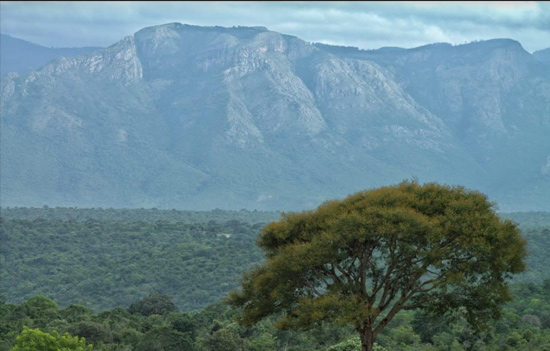 Nilgiris as seen from Bandipur, Karnataka. Pic taken during stay in Dhole's Den, Bandipur
Nilgiris as seen from Bandipur, Karnataka. Pic taken during stay in Dhole's Den, BandipurFor most tourists, the usual destinations
in the Nilgiris are the towns of Ooty, Coonoor, Wellington and Kotagiri. These
places have numerous lakes, gardens, waterfalls and mountain viewing points to
boast of. Not to take anything away from these locations, I have found some of
the off grid places more fascinating that give you the true Nilgiris
experience. This post is about some of these extraordinary locales off Ooty and
Coonoor.
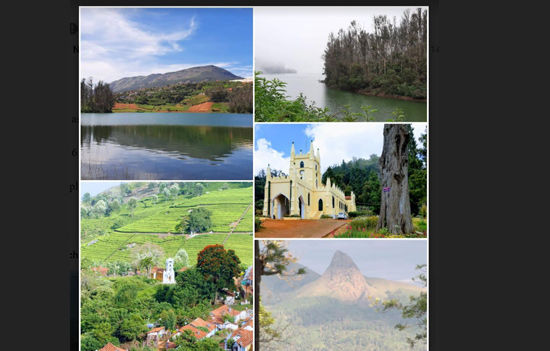
The heritage buildings of the hill
station towns are still a point of interest for me. As most of these towns were
the getaway stations for the British as well as transit and recreational hubs
for planters in the Nilgiris, they are home to many century old heritage
buildings. Many of them are hotels, restaurants, government offices today,
while some of the old tea bungalows continue to function as such.
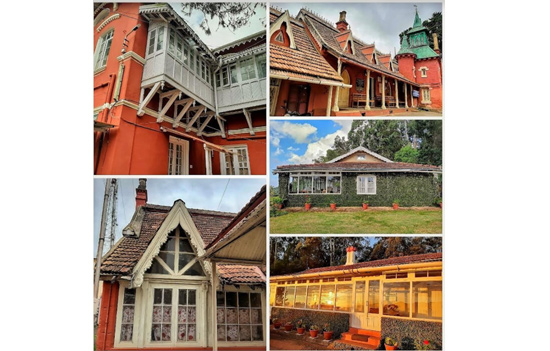
The real gems lie away from these
highly thronged hill towns. There are these pristine lakes, deep green valleys
and tea estates tucked away in distant hills that rub shoulders with the wild.
Most farm lands, and in particular the tea estates, are a result of invasive
cultivation on forest lands, much of which occurred about a hundred or more
years ago. As the world continues to sip its most loved beverage, you realize
that this has come at a cost.
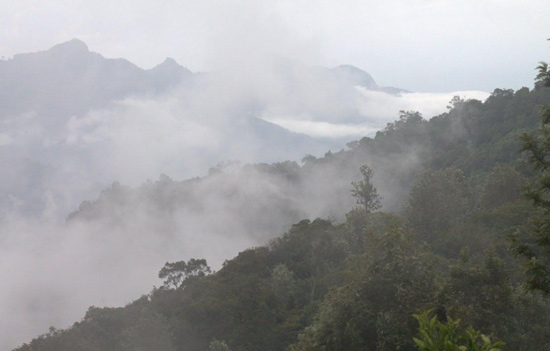 A view of the Nilgiris off Coonoor, before it lowers itself into Mettupalayam-as seen from Nonesuch Tea Estate.
A view of the Nilgiris off Coonoor, before it lowers itself into Mettupalayam-as seen from Nonesuch Tea Estate.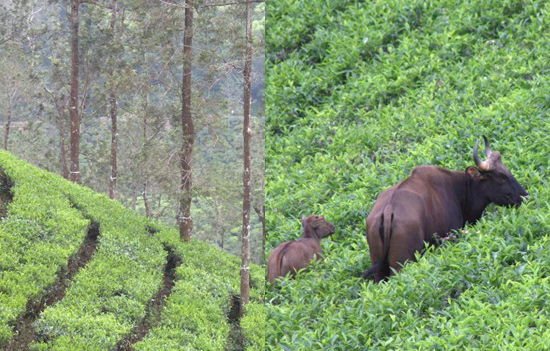 The proximity of the plantations to the wild present these common sights.
The proximity of the plantations to the wild present these common sights.Full caption - A gaur and its calf
feeding on the under growths of tea plantations. This can lead to breeding with
domestic cattle as many naturalists fear, potentially causing irreversible
consequences.
Some of my favourite places for stay
in the Nilgiris are in the Emerald/Avalanchi regions and tea estates beyond the
towns of Conoor and Gudalur. The quiet nights with faraway village lights
glistening on hill slopes, the sounds of plantation activities in the day, the
rustling of leaves as the winds swirl round the hills, all add to create the
most calming ambience for a relaxed stay.
 Tea plantations merge with forest lands-a view from Nonesuch Tea Estate.
Tea plantations merge with forest lands-a view from Nonesuch Tea Estate.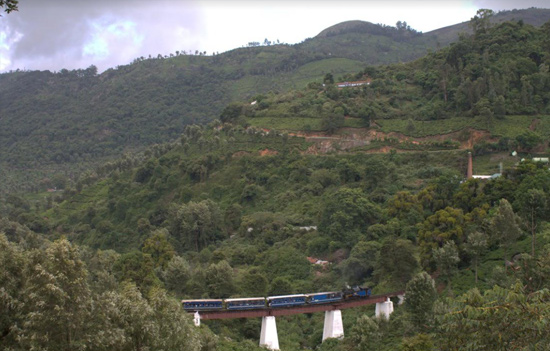 A Nilgiri Mountain Railway train on way to Mettupalayam from Coonoor.
A Nilgiri Mountain Railway train on way to Mettupalayam from Coonoor.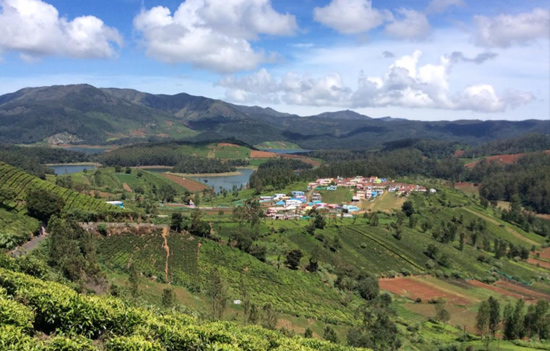 Colorful facades of village houses dot the landscape surrounding the Emerald Lake.
Colorful facades of village houses dot the landscape surrounding the Emerald Lake.The Nilgiri Mountain Railway is an
attraction for those that look for that “toy train” experience in the
mountains. This railway provides an important connection between Mettupalayam
and Ooty and travellers get to chug through tunnels and over deep valleys and
gushing waterfalls. Not quite bearing the cute “toy” kind of a look of the
railways running in hill stations like Darjeeling (this one is a metre gauge
track unlike the latter which is narrow gauge), this still holds a premium
position in tourists’ to do lists.
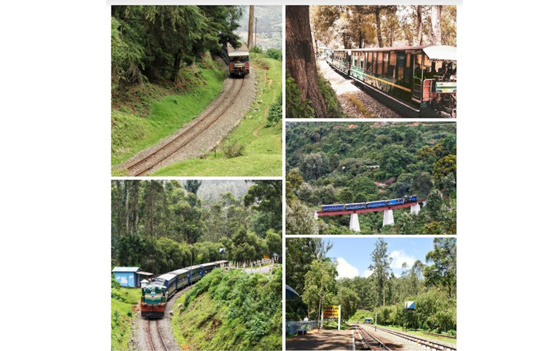
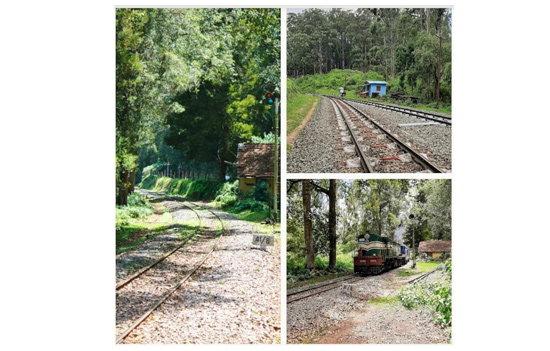 The Nilgiri Mountain Railway-a 46 km long service takes you along almost all landscapes of the Nilgiris.
The Nilgiri Mountain Railway-a 46 km long service takes you along almost all landscapes of the Nilgiris.An interesting fact about the Nilgiri
Mountain Railway: the Coonoor Mettupalayam stretch has a very steep gradient
and hence this route employs a “rack and pinion” arrangement to assist the
climb to Coonoor. Notice the rack running in between the two rails of the
track, in the following image.

The Emerald and the Avalanchi lakes
and their surroundings offer some breath-taking sights. The two lakes feed each
other, being connected at a narrow neck. They also receive water from lakes
located at higher altitudes, an arrangement made to support some of the hydro-electric
power stations in the region.
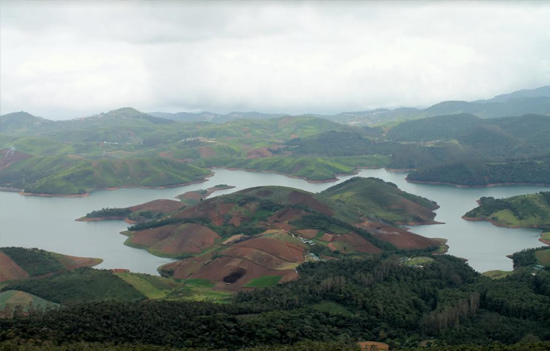 The Avalanchi Lake viewed from an adjacent peak.
The Avalanchi Lake viewed from an adjacent peak. The Emerald under the sun, as viewed from Red Hill Nature Resort.
The Emerald under the sun, as viewed from Red Hill Nature Resort. If you are wary of the beeline of
tourists to Ooty and Coonoor and yet want to quietly enjoy the Nilgiri clime,
look for a bungalow stay in the midst of tea plantations away from these main
towns. Red Hill Nature Resort in Emerald, Nonesuch Tea Estate near Coonoor and
Parry Agro’s Sinnadorai Bungalow (Mangorange) in Pandhalur offer some of the
most delightful leisure experiences that I had in the hills. So I keep going
back to them.
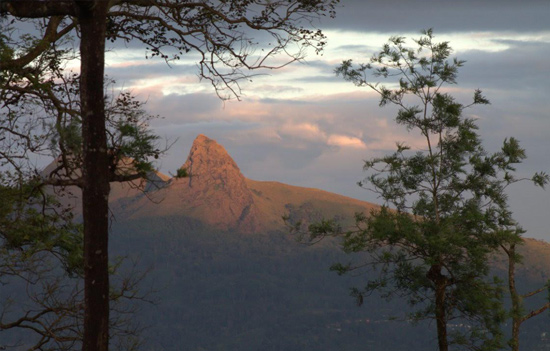 The Needle Rock peak in falling sunlight-view from Mangorange Sinnadorai Bangalow, Pandhalur.
The Needle Rock peak in falling sunlight-view from Mangorange Sinnadorai Bangalow, Pandhalur. Look around and you will be greeted with the beautiful and the extraordinary.
Look around and you will be greeted with the beautiful and the extraordinary.The Nilgiris, like the Western Ghats
that it is a part of, has rightly been included as a UNESCO World Heritage
site. The rich biodiversity, local tribes and the large number of species that
are endemic to the region are forever under stress from growing human
incursions.
While tourism is an important source
of living for many in the Nilgiris, as one can expect this does leave an
imprint on the land. While the local administrations, NGOs and global
institutions work very hard to ensure that a balance is struck between human
led growth and sustainability of the ecology, visiting tourists have a role to
play in this too.
Responsible tourism is one of the
answers to questions raised on human ingress dealing a death blow to the
sensitive ecology of the Ghats. Conscious adherence to the rules laid by the
local administrations and forest departments is the least visiting travellers
can do to help retain the splendour of the region. Let us, the visitors, commit
ourselves to that.
To read all travelogues by author
Author is a Bengaluru
based professional.
To
visit author’s travel blog
To read all articles in India Travels and Yatras
section